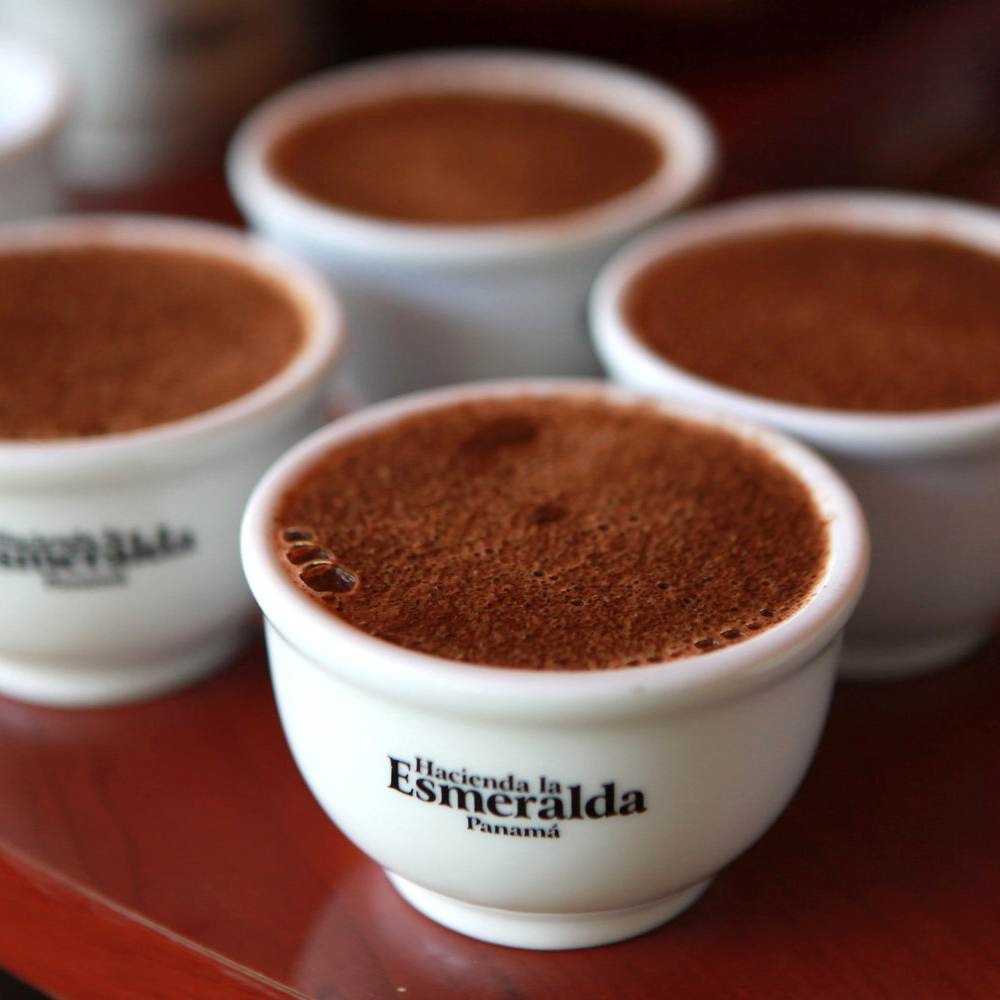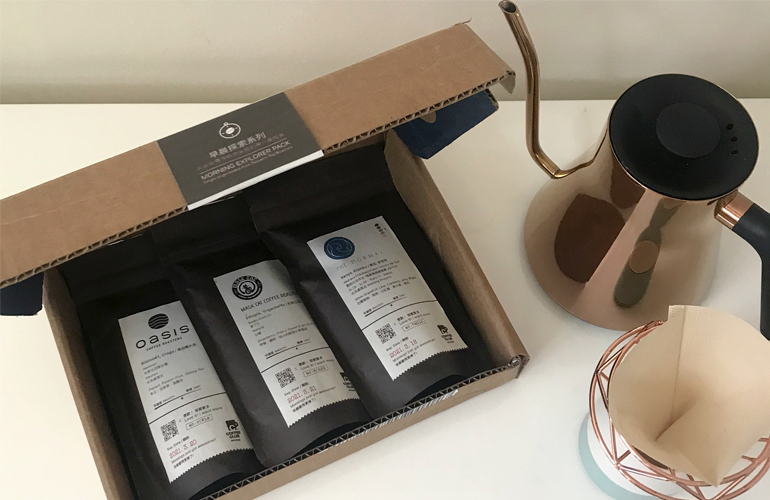Coffee Info
咖啡的風味遊戲
The Coffee Flavor Game

Photo by Hacienda la Esmeralda
You’ve probably noticed those “odd” tasting notes on your single origin coffee bag, referencing jasmine, lychee, or, perhaps, perilla plums. Wondering what’s up with that? Let’s break down the purpose and methods coffee graders use to describe coffee.
Notes are just notes, not songs
Remember, the main flavor in coffee is–COFFEE. Think of that as the ”Song”. Songs are made up of many notes, some high, some low, some harmonious, some dissonant.
Coffee graders are trained in sensory science, to use real world flavor experiences to describe something that’s incredibly complex, identifying the closest real life equivalent that they find in the coffee they’re tasting. This is generally based on standardized taste properties. The result is a series of notes that add color and depth to the “song”.
Here are the 5 categories that generally appear in Coffee Notes:
1. Aroma
Aroma is what’s experienced in the nose both before and during coffee tasting. Aroma notes describe unique characteristics beyond a coffee smell, drawn from real life sensations. For example, Yirgacheffe beans are known for having a hint of floral or citrus. Darker roasts frequently feature chocolate, caramel or nutty aromas…or just a slightly burnt smell in the case of Starbucks espresso drinks. In a great coffee, aroma works together with the other 4 aspects to create a masterful symphonic work.
2. Acidity
Acidity is a technical term used by coffee graders to refer to a bright, clean, tartness, frequently associated with citrus fruit, that adds to the overall flavor. A coffee can have a high acidity but also a residual sweetness or richness that creates a smooth finish. Acidity shouldn’t be confused with ”sour”, which refers to an overall unpleasant flavor associated with poor bean quality. Low-acid coffees tend to be smoother or possess some bitterness, as might be found in chocolate.
3. Body/Mouth Feel
When you drink coffee you’ll quickly notice whether or not it has an elegant, pleasing, balanced flavor and smooth finish, whether it’s kind of thin––a modest note of flavor that peters out, or whether it has an especially vibrant and intense mouth feel.
4. Flavor
Flavors are the complexities and subtleties that makes some coffees superstars and relegates others to “everyday” status. Think of flavor notes as describing some property of the reported flavor, rather than directly comparing the coffee to that product.
You’ll see references to specific fruits, sugars, chocolate, flowers, tea, or nuts; but, if you see ”plum juice”, for example, don’t expect to taste plum juice––rather, expect some special quality found in plum juice, a unique sweet-sour taste, for example.
Many great coffees coffees are associated with certain tastes. Yirgacheffe is associated with berry and citrus, Geisha with lemon zest, Colombian beans with nuts, caramel, and chocolate, and Sidamo with blueberries. Newer processing methods such as honey and rum barrel processing create additional taste sensations, such as a plum, wine and whiskey notes.
5. Aftertaste
As with wine, some coffees are clean and crisp, with little aftertaste. Others have a rich long finish. Bardem, a Taiwan-grown coffee (from Yunlin County), has a strongly bitter taste that resolves into a sweet aftertaste. It’s one of my favorite Taiwan coffees because of those characteristics.
In closing…
How each batch of beans is roasted and the freshness of the green beans used has a marked effect on resulting flavor. Finding a roaster that respects the ideal flavor profiles of each bean and works to bring out these qualities is extremely important.
Happy cupping!
Warren
你可能已經注意到你的單品咖啡豆袋上的那些 “奇怪“ 的風味筆記。想知道這是怎麼回事?讓我們來分析咖啡品質鑑定師,用來描述咖啡的方法和目地。風味筆記只是音符,不是歌曲。
請記得,咖啡的主要風味是——COFFEE, 可將其視為“歌曲“。歌曲由許多音符組成,有的高,有的低,有的和諧,有的不和諧等等。
咖啡品鑑師接受過感官科學方面的培訓,能夠使用現實世界的風味體驗來描述極其複雜的東西,確定他們在品嚐的咖啡中,發現的最接近現實生活的等值物。這通常建立於標準化的味道特性。結果是一系列的音符,為“歌曲“增添了色彩和深度。
以下是咖啡風味筆記中通常出現的 5 個層面:
1. 香氣- Aroma
香氣是在品嚐咖啡之前和期間,從鼻子中體驗到的。香調描述了咖啡氣味之外的獨特特徵,來自現實生活的感受。例如,耶加雪菲豆以帶有一絲花香或柑橘香而聞名。較深的烘焙通常帶有巧克力、焦糖或堅果的香味……或者像是星巴克濃縮咖啡飲料,有一些輕微的焦味。在一個各式的咖啡香氣與其他 4 個層面一起合作,創造一個極佳的交響樂作品。
2. 酸度- Acidity
酸度是咖啡品鑑師使用的一個技術性術語,表示明亮,乾淨的酸味,通常與柑橘類水果有關,通常會增加整體風味。咖啡可以具有高酸度,但也可以具有殘留的甜味或豐富度,產生滑順的尾韻。酸度不應與 “酸味“ 混淆,“酸味“ 指與低品質豆相關的整體令人不快的味道。低酸咖啡往往口感更滑順,或帶有一些苦味,就像巧克力中可能發現到的那種。
3. 身體/嘴巴的感受- Body/Mouth Feel
當你喝咖啡時,你會很快注意到它是否具有優雅、令人愉悅、均衡的整體口感和滑順的餘味。風味可能會有點稀薄——一種入口逐漸消失的溫和味道,或者在你的嘴裡可能感受特別鮮明和強烈的某種風味。
4. 風味- Flavor
風味的複雜性和微妙之處, 讓一些咖啡成為超級明星, 並將其他降級為“日常” 咖啡。可以將風味註解視為描述風味的某些特性,而不是直接將咖啡與該產品進行比較。你會看到針對特定水果、糖、巧克力、花、茶或堅果名稱的提及;但是,如果你看到“李子汁“,不要指望嚐到李子汁的味道——相反的,應該期待李子汁中的一些特殊品質,例如一種獨特的酸甜口味。
許多很棒的咖啡都與某些口味有關。耶加雪菲與莓果,有時是柑橘。藝妓與檸檬皮、哥倫比亞豆與堅果、焦糖和巧克力,以及 Sidamo 與藍莓有關。較新的處理法,如蜜處理,和蘭姆酒桶浸漬,會產生額外的味覺,例如葡萄酒和威士忌的味道。
5. 餘味- Aftertaste
與葡萄酒一樣,有些咖啡乾淨清脆,幾乎沒有餘味。其他有豐富的悠長尾韻。 Barden, 巴登是我最喜歡的台灣產咖啡豆之一(來自雲林縣),具有強烈的苦味,然後回甘有甜美的餘味。由於這些特點,它是我最喜歡的台灣咖啡之一。
在結束前…
每批豆子的烘焙方式和所用生豆的新鮮度,對風味的產生有顯著影響。找到一個尊重每種豆子的理想風味特徵,並努力發揮這些特質的烘豆師是非常重要的。
祝杯測愉快!
Warren


